
Catalog excerpts

KVM over IP Matrices for Broadcast Applications MICHEL PUDELLE EMEA Regional Manager
Open the catalog to page 1
WHITE PAPER: KVM over IP Matrices for Broadcast Applications Introduction The need for KVM extension and switching solutions in the Broadcast industry came along-side the use of computers in all aspects of content creation, editing, storage, distribution, etc. Over the years, an ever-increasing percentage of “tasks” were accomplished with software running on computers instead of using dedicated equipment. With dedicated hardware equipment, the control surface is usually installed in the operator’s room while the equipment chassis is in the technical room. The need for having the “computer...
Open the catalog to page 2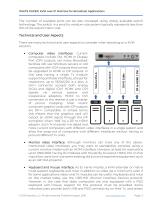
WHITE PAPER: KVM over IP Matrices for Broadcast Applications The number of available ports can be also increased using widely available switch technology. The switch in a small to medium size system typically represents less than 10% of the overall matrix cost. Technical and User Aspects There are many technical and user aspects to consider when deciding on a KVM solution. Computer video interfaces: Current computers include DVI, HDMI or Display Port (DP) outputs, yet many Broadcast facilities still use Windows servers or old computers with VGA outputs that cannot be upgraded to HDMI or DP...
Open the catalog to page 3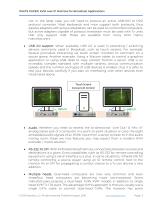
WHITE PAPER: KVM over IP Matrices for Broadcast Applications not. In the latter case, you will need to procure an active USB-HID to PS/2 protocol converter. Most keyboards and mice support both protocols, thus passive adapters with pinout adaptation can be used to control PS/2 computers, but active adapters capable of protocol translation must be used with Tx units that only support USB. These are available from many KVM matrix manufacturers. • USB 2.0 support. When available, USB 2.0 is used in extending / switching devices commonly used in Broadcast, such as touch screens. For example:...
Open the catalog to page 4
WHITE PAPER: KVM over IP Matrices for Broadcast Applications drawbacks, as you will need to replace the Tx or the Rx if you decide to turn a single head computer / console into a dual-head version. Furthermore, it is not easy to go beyond two heads. The Apantac approach is to always use single head Tx/Rx models and to have “logical” two, three or four heads versions. For example: to interface a dual-head computer, you will use a main Tx that will transport the video and USB and a slave Tx that will accept the second head video. Functionally, you only switch the main Tx to the main Rx and,...
Open the catalog to page 5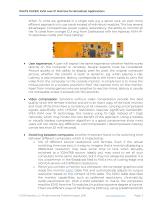
WHITE PAPER: KVM over IP Matrices for Broadcast Applications When Tx units are gathered in a single rack e.g. a server rack, an even more efficient approach is to use cards instead of individual modules. This has several advantages: Compactness, power supply redundancy, the ability to monitor all the Tx cards from a single GUI (e.g. from Dashboard with the Apantac KVM-IPTx openGear cards) and “neat cabling.” User experience. A user will expect the same experience whether he/she works directly on the computer or remotely. Several aspects must be considered: Picture quality or the ability to...
Open the catalog to page 6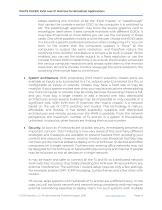
WHITE PAPER: KVM over IP Matrices for Broadcast Applications tables, electing one monitor to be the “EDID master,” or “passthrough” that carries the console monitor EDID to the computer it is switched to etc. The passthrough approach may force the source graphics card to reconfigure itself when it sees console monitors with different EDIDs. It may take 10 seconds or more before you can use the computer in these cases. One of the possible choices is to let the user choose one EDID table in a list with a specific preferred resolution when configuring a Tx. You can then, to the extent that the...
Open the catalog to page 7
WHITE PAPER: KVM over IP Matrices for Broadcast Applications console positions and users, you will likely look for solutions that define password protected profiles, with logging and alarming capabilities, encrypted transmissions, etc. One feature you may need when selecting a KVM over IP solution is transparency with HDCP (High-bandwidth Digital Content Protection) protocol. There are basically two mechanisms at play: A constant handshake between the source and the monitor. If the handshake does not happen, the source will stop sending the signal. Then the video content is encrypted, thus...
Open the catalog to page 8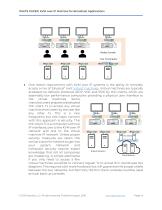
WHITE PAPER: KVM over IP Matrices for Broadcast Applications Backup Console Two Tx Computer One recent requirement with KVM over IP systems is the ability to remotely access a mix of “physical” and “virtual” machines. Virtual machines are typically accessed via network protocols (RDP, VNC and SSH) by thin clients, which are essentially low performance computers providing a physical user interface to the virtual machines. Some manufacturers propose a dedicated thin client Tx to access any virtual machine that is seen by the user like any other Tx. This is a nice integration but one major...
Open the catalog to page 9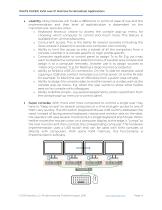
WHITE PAPER: KVM over IP Matrices for Broadcast Applications Usability. Many features will make a difference in terms of ease of use and the implementation and their level of sophistication is dependent on the manufacturer. Here are a few: o Keyboard shortcut choice to access the console pop-up menu for choosing which computer to control and much more. This feature is available from all manufacturers. o Concurrent access. This is the ability for several consoles (including the local console if present) to access one computer concurrently. o Ability to limit the access to only a subset of...
Open the catalog to page 10
WHITE PAPER: KVM over IP Matrices for Broadcast Applications An even more flexible approach is to connect the Rx console video outputs to the inputs of a multiviewer with built-in KVM capability. The functionality is the same as above, but the physical console monitors are replaced by resizable and repositionable PIPs (picture in picture) on a single large monitor. Different PIP layouts including full screen can be created and recalled. At Apantac, we have several multiviewer models with HDMI 2.0, UHD / 4K resolution inputs and outputs with built-in KVM capability that are a perfect fit for...
Open the catalog to page 11All Apantac LLC. catalogs and technical brochures
-
TAHOMA T#
14 Pages
-
Product portfolio
12 Pages
-
Apantac Multiviewer Catalog
15 Pages
-
DL
4 Pages
-
DE Multiviewers
4 Pages
-
IP Multiviewers
15 Pages







